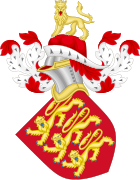Tallage
| English feudalism |
|---|
 |
| Manorialism |
| Feudal land tenure in England |
| Feudal duties |
| Feudalism |
Tallageortalliage(from theFrenchtailler,i.e. a part cut out of the whole) may have signified at first anytax,but became in England and France a land use or land tenure tax. Later in England it was further limited to assessments by the crown uponcities,boroughs,androyaldomains. In effect, tallage was aland tax.
England
[edit]Land taxes were not unknown in England, as the Anglo-Saxon kings had periodically levied aDanegeldon that basis, but tallage was brought to England by theNormansas a feudal duty. The word first appeared in the reign ofHenry IIas a synonym for theauxilium burgi,which was an occasional payment exacted by king andbarons.[1]Under Henry's sons it became a common source of royal revenue. It was condemned in theMagna Cartaof 1215, and its imposition practically ceased by 1283 in favour of a general grant made inParliament.There were three further attempts to impose tallage, and it was formally abolished in England in 1340 (Taxation, etc. Act 1340) underEdward III,when Parliament's consent to the imposition of common charges became required.[1]
Likescutage,tallage was superseded by various property and trade taxes, and then the subsidy system in the 14th century, which involvedpoll taxes.The last occasion on which tallage was levied in England appears to be about the year 1332.[2]
| Act of Parliament | |
 | |
| Long title | Statutum de Tallagio non concedendo |
|---|---|
| Citation | 25 Edw. 1 |
| Dates | |
| Royal assent | 1297 |
| Other legislation | |
| Amended by | Statute Law Revision Act 1887,Statute Law (Repeals) Act 1969 |
| Relates to | Magna Carta (1297),Charter of the Forest,Confirmation of the Charters (1297) |
Status: Current legislation | |
| Text of the A Statute Concerning Tallage (1297)as in force today (including any amendments) within the United Kingdom, fromlegislation.gov.uk. | |
The famous statute of25 Edw. 1(34 Edw. 1. Stat. 4 inThe Statutes at Large),De Tallagio non Concedendo,though it is printed among the statutes of the realm, and was cited as a statute in the preamble to thePetition of Rightin 1628, and by the judges inJohn Hampden'scase in 1637, is probably an imperfect and unauthoritative abstract of theConfirmatio Cartarum.[2][1]The first section enacts that no tallage for aid shall be imposed or levied by thekingand his heirs without the will and assent of thearchbishops,bishops,and otherprelates,theearls,barons,knights,burgesses,and other freemen in the kingdom.[2]
No Tallage or Aid shall be taken or levied by Us or our Heirs in our Realm, without the good will and Assent of the Archbishops, Bishops, Earls, Barons, Knights, Burgesses, and other Freemen of the Land.
Tally sticks
[edit]Tallagiumfacerewas the technical term for rendering accounts in theExchequer,the accounts being kept by means oftalliesor notched sticks. Thetellers(a corruption oftalliers) of the Exchequer were at one time important financial officers.
The system of keeping the national accounts by tallies was abolished by theReceipt of the Exchequer Act 1783(23 Geo. 3.c. 82) and the office of teller by theOffices of Exchequer Act 1817(57 Geo. 3.c. 84).[2]
Tallage and Jews
[edit]The tax was frequently levied on English Jews during the twelfth and thirteenth centuries. A tallage of £60,000, known as the "Saladin tallage",was levied atGuildfordin 1189, the ostensible object being preparation for theThird Crusade.[3]
It was reported thatJohnmay have imposed a tallage upon Jews in 1210 to the extent of 60,000 marks (£40,000). There are likewise records of tallages underHenry IIIof 4,000 marks (1225) and 5,000 marks (1270).[3]Important tallages were made byEdward Iin the second, third and fourth years (£1,000), and in the fifth year (25,000 marks), of his reign.[3]These taxes were in addition to the various claims which were made upon Jews for relief,wardship,marriage,fines,law-proceedings,debts,licenses,amercementsetc. and which Jews paid to the English exchequer, like other English subjects.[3]
It has been claimed that after their expulsion from England in 1290, the loss of the income from Jews was a chief reason why Edward I was obliged to give up his right of tallage upon Englishmen.[3][4]
France
[edit]Tallage lasted much longer in France, where it was a royal tax and one of estate owners with tenants. It came to be called 'taille' and was much used during theHundred Years' War.It was not abolished in France until theFrench Revolution.
Germany
[edit]Tallage never became significantly developed in the German states. It remained a small tax owed to a feudal lord in lieu of other feudal duties, dying out along with other feudal duties.
See also
[edit]References
[edit]- ^abcChisholm, Hugh,ed. (1911)..Encyclopædia Britannica.Vol. 26 (11th ed.). Cambridge University Press. p. 372.
- ^abcdBaynes, T. S.; Smith, W. R., eds. (1888)..Encyclopædia Britannica.Vol. 23 (9th ed.). New York: Charles Scribner's Sons. p. 29.
- ^abcde
 Singer, Isidore;et al., eds. (1901–1906)."Tallage".The Jewish Encyclopedia.New York: Funk & Wagnalls.
Singer, Isidore;et al., eds. (1901–1906)."Tallage".The Jewish Encyclopedia.New York: Funk & Wagnalls.
- ^Rokéah, Zefira Entin (1994). "A Hospitaller and the Jews: Brother Joseph de Chauncy and English Jewry in the 1270s".Jewish Historical Studies.34.Jewish Historical Society of England: 189–207.JSTOR29779959.
Bibliography
[edit]- Fuller, E. A. (1895)."The Tallage of 6 Edward II., and the Bristol Rebellion"(PDF).Transactions of the Bristol and Gloustershire Archaeological Society.19:171–278.
- This article incorporates text from a publication now in thepublic domain:Baynes, T. S.; Smith, W. R., eds. (1888)..Encyclopædia Britannica.Vol. 23 (9th ed.). New York: Charles Scribner's Sons. p. 29.
- This article incorporates text from a publication now in thepublic domain:Chisholm, Hugh,ed. (1911). "Tallage".Encyclopædia Britannica.Vol. 26 (11th ed.). Cambridge University Press. p. 372.
 This article incorporates text from a publication now in thepublic domain:Singer, Isidore;et al., eds. (1901–1906)."Tallage".The Jewish Encyclopedia.New York: Funk & Wagnalls.
This article incorporates text from a publication now in thepublic domain:Singer, Isidore;et al., eds. (1901–1906)."Tallage".The Jewish Encyclopedia.New York: Funk & Wagnalls.
Further reading
[edit]- Bailey, Mark(February 2019)."Tallage-at-will in later medieval England".The English Historical Review.134(566): 25–58.doi:10.1093/ehr/cez002.
